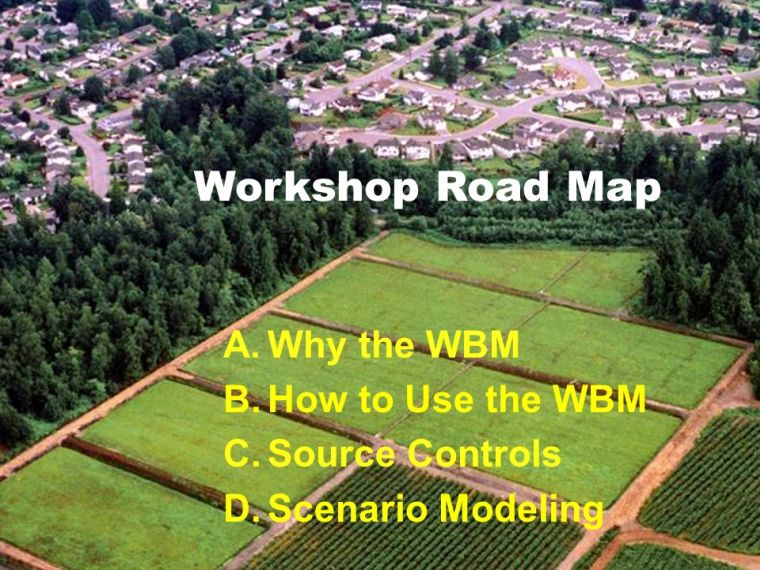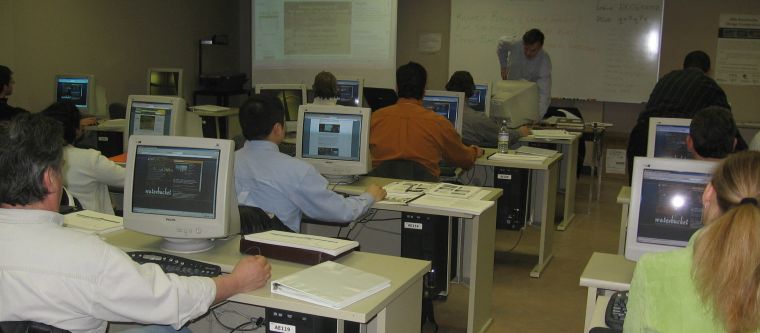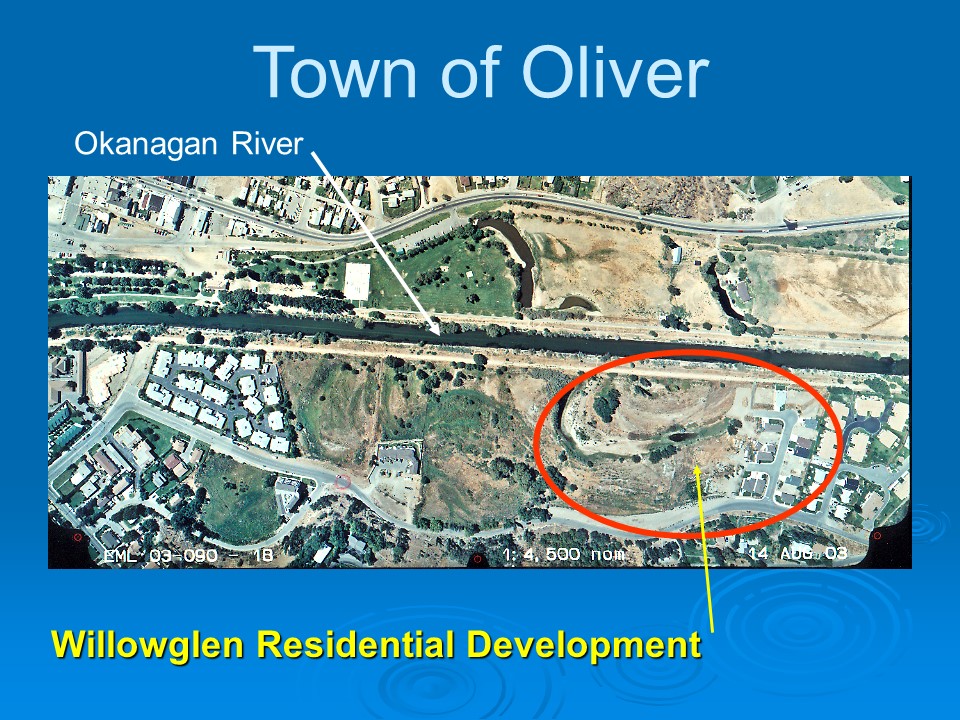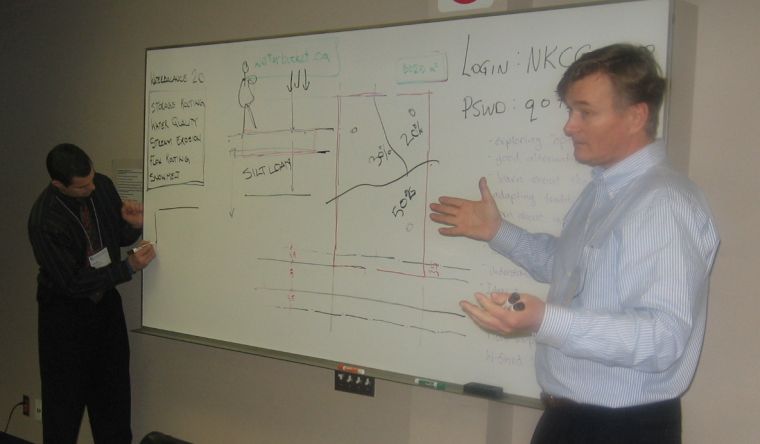Rainwater Management and ‘Green’ Subdivision Design: Water Balance Model Training Workshop held at UBC-Okanagan University to introduce a design with nature’ approach
Note to Reader:
In February 2006, the University of British Columbia Okanagan was the venue for a training workshop on the Water Balance Model for British Columbia, a web-based decision support and scenario modeling tool for rainwater source control evaluation.
Organized by the Association of Professional Engineers and Geoscientists of BC (APEGBC) in collaboration with the Inter-Governmental Partnership, the workshop was initiated by the City of Kelowna to provide Southern Interior design professionals and others with hands-on training in a computer lab setting.

The Water Balance Model: A Tool for Applying Design with Nature Principles to Rainwater Management
Developed as an extension of Stormwater Planning: A Guidebook for British Columbia, the Water Balance Model was formally launched at the 2003 Union of British Columbia Municipalities Annual Conference.
The Guidebook formalized a science-based understanding to set performance targets for reducing rainwater runoff volumes and rates. These targets represent the synthesis of biological and hydrological understanding in order to ‘design with nature’.
 “UBC-Okanagan is pleased to have provided the venue for this application of sustainability-on-the-ground. This sponsorship opportunity was an outcome of a meeting with the Chair of the Inter-Governmental Partnership, at which time we realized that UBC-Okanagan and the IGP shared a common objective in advancing the state-of-the-art for water management in the Okanagan”, according to Bernard Bauer, Dean ot the Irving K. Barber School of Arts and Sciences.
“UBC-Okanagan is pleased to have provided the venue for this application of sustainability-on-the-ground. This sponsorship opportunity was an outcome of a meeting with the Chair of the Inter-Governmental Partnership, at which time we realized that UBC-Okanagan and the IGP shared a common objective in advancing the state-of-the-art for water management in the Okanagan”, according to Bernard Bauer, Dean ot the Irving K. Barber School of Arts and Sciences.
 According to Ted van der Gulik (Ministry of Agriculture & Lands) and Chair of the Inter-Governmental Partnership, “The training workshop was developed in response to interest arising from the success of three outreach and communication events that were held in the cities of Kelowna and Kamloops during the October/November 2005 period. Through events such as these, our goal is to advance the Design with Nature way-of-thinking and acting.”
According to Ted van der Gulik (Ministry of Agriculture & Lands) and Chair of the Inter-Governmental Partnership, “The training workshop was developed in response to interest arising from the success of three outreach and communication events that were held in the cities of Kelowna and Kamloops during the October/November 2005 period. Through events such as these, our goal is to advance the Design with Nature way-of-thinking and acting.”
Endorsements
 The Real Estate Foundation of British Columbia is a supporter of the Water Balance Model and has played a major role in funding its development. According to Tim Pringle, Executive Director, “The Foundation believes the Water Balance Model is an essential tool for practitioners solving rainwater management challenges.”
The Real Estate Foundation of British Columbia is a supporter of the Water Balance Model and has played a major role in funding its development. According to Tim Pringle, Executive Director, “The Foundation believes the Water Balance Model is an essential tool for practitioners solving rainwater management challenges.”
 The Pacific Region of the Urban Development Institute has also endorsed use of the Water Balance Model. “UDI supports the ongoing development of the Water Balance Model as a practical tool for building sustainable communities”, according to Maureen Enser, Executive Director. In April 2004, UDI sponsored the first WBM training workshop at the BC Institute of Technology. This followed a breakfast seminar to introduce the WBM to the UDI membership.
The Pacific Region of the Urban Development Institute has also endorsed use of the Water Balance Model. “UDI supports the ongoing development of the Water Balance Model as a practical tool for building sustainable communities”, according to Maureen Enser, Executive Director. In April 2004, UDI sponsored the first WBM training workshop at the BC Institute of Technology. This followed a breakfast seminar to introduce the WBM to the UDI membership.
To Learn More:
For background and context, download The Green Infrastructure Partnership: Convening for Action in British Columbia (July 2005 Progress Report).

Workshop Program
“The training workshop is interactive and involves team-teaching in order to provide personalized instruction and/or assistance as needed to work through real scenarios. All workshop participants have their own work station,” stated Kim Stephens, Project  Coordinator for the Inter-Governmental Partnership, and leader of the Water Balance Model Training Team.
Coordinator for the Inter-Governmental Partnership, and leader of the Water Balance Model Training Team.
“Our objective is to create an atmosphere that makes learning fun. At the end of the session, participants have an appreciation that the tool is a means to an end in promoting change in the way we think about the relationship between the built and natural environments,” added Stephens.
To Learn More:
Download a copy of the Lesson Plan.
Download a copy of the Workshop Binder.

Four Parts
The full-day workshop program was developed with input from two specialists in continuing education at Royal Roads University, and organized in four parts. Click on the links below to download each of the four PowerPoint presentations:
- Session A: Why the Water Balance Model – Changing Water Management Practices at the Site Level.
Session A Outcome: Participants will be able to identify and express why we need to change the way we develop land and manage water at the site level. - Session B: How to Use the Water Balance Model – Simulating the Rainfall- Runoff Process.
Session B Outcome: Participants will be able to use the Water Balance effectively to enter input data and generate outputs. - Session C: Application of Source Controls – Achieving Performance Targets for Runoff Reduction.
Session C Outcome: Participants will understand the capabilities of the Water Balance Model to evaluate rainwater source controls and how to achieve performance targets for volume reduction and rate control. - Session D: Application of Scenario Modeling – Making Better Decisions.
Session D Outcome: Participants will be able to apply judgement in using the Water Balance Model effectively to produce practical and achievable solutions in real-life situations.

Richard Boase – providing personalized instruction
Case Study
The Willowglen subdivision in the Town of Oliver was used as a case study example to illustrate the application of scenario modelling to achieve performance targets, while at the same time making the exercise realistic.
Participants worked in teams to apply source controls to the subdivision. The focus of the exercise was on the choices for achieving the 10% runoff volume target.
The objective was to apply judgement in using the WBM effectively to produce practical and achievable solutions in real-life situations.

Integrated Solutions
An essential element of the ‘integration of water sustainability and green infrastructure’ messaging is that the manner in which one treats or develops the urban landscape impacts on both water that is applied and water that runs off – that is, water supply and drainage, respectively. At the end of the day, it comes down to soil and vegetation.
The Water Balance Model for British Columbia quantifies the benefits – in terms of reducing rainwater runoff volume – of installing source controls under different combinations of land use, soil and climate conditions. It helps visualize the ‘how to’ details of source control implementation, and can be used as follows to make better decisions through a defensible, interactive and transparent process:
- Local Governments: when communicating with the public
- Planners and Engineers: when setting performance targets
- Developers and their Consultants: when testing scenarios
- Environmental Agencies: when monitoring watershed health
“The tool enables assessment of the effectiveness of site designs that incorporate rainwater source controls such as absorbent landscaping, rain gardens, infiltration facilities and green roofs. The Water Balance Model can be applied at three scales: site, subdivision and watershed,” stated Richard Boase (District of North Vancouver), a member of the three-person Water Balance Model Training Team.
“ Use of the tool will help design professionals understand what ‘thinking outside the pipe’ and ‘designing with nature’ actually mean in the context of ‘green’ subdivisions that have been built in recent years in British Columbia.
Use of the tool will help design professionals understand what ‘thinking outside the pipe’ and ‘designing with nature’ actually mean in the context of ‘green’ subdivisions that have been built in recent years in British Columbia.
“My role is to provide the regulatory perspective. I think of myself as the colour man because of the manner in which I tag-team with Kim Stephens who does the play-by-play in weaving the workshop storyline. Doug Backhouse, the third member of our team, is the technical director because he is the one who leads students through the online applications of the Water Balance Model,” added Boase.

Richard Boase (left) and Doug Backhouse (right) explain the finer points of the Water Balance Model


